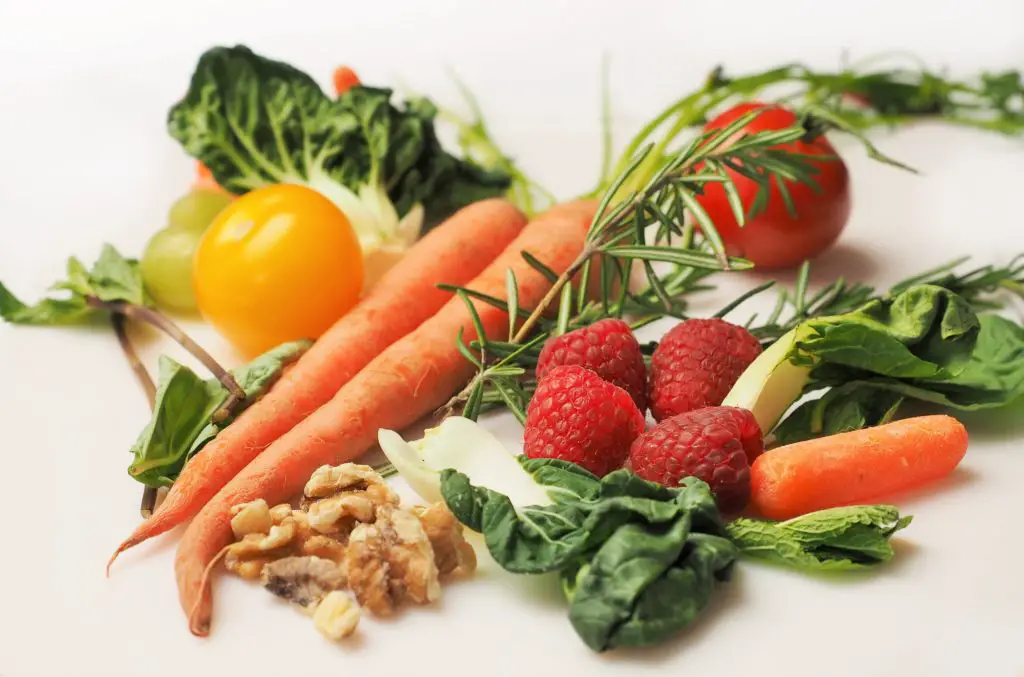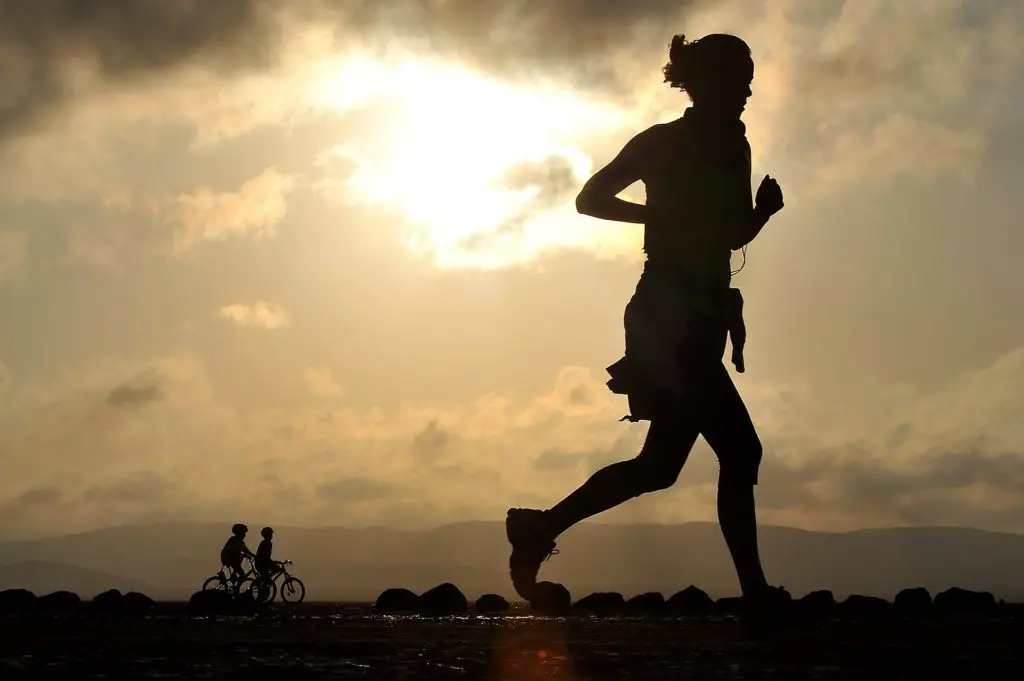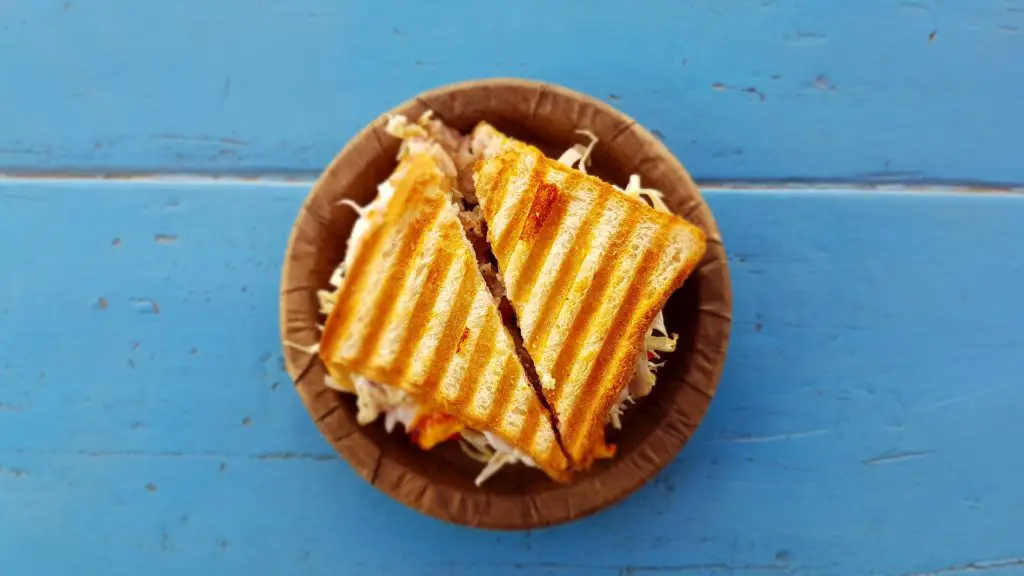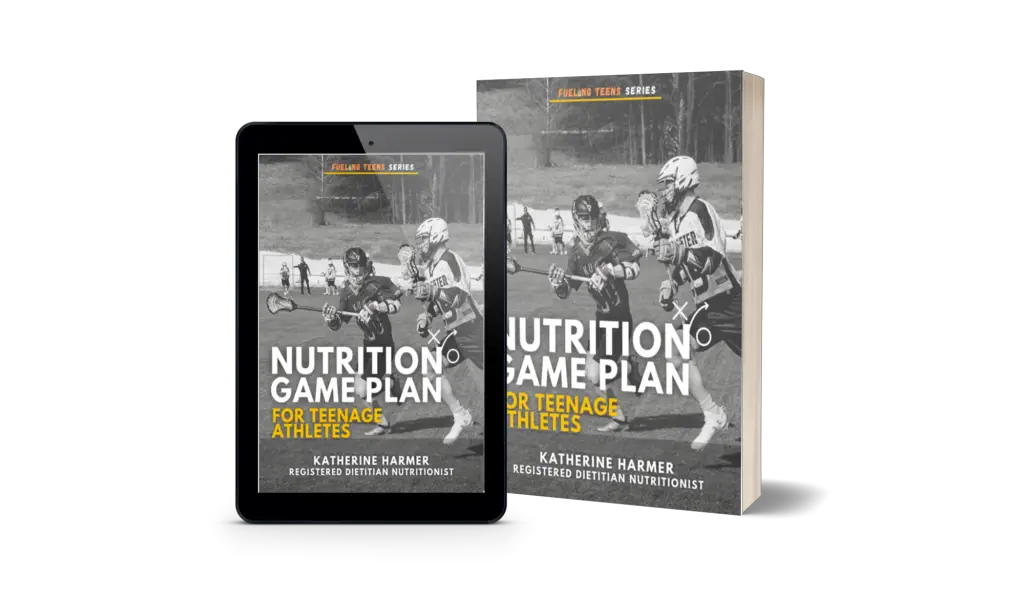Maybe you are the parent of a teenage athlete, or you are the teenage athlete. Either way, someone needs to make sure teenage athletes are getting the right amount of food, and the right types of foods to fuel their competition.
Active teenagers need 2,500 to 3,000 calories per day to stay healthy and fueled for sports. The average high school female requires around 2,000 calories and the average male requires around 2,800 calories per day. Add sports to their plate, and teenage athletes need extra calories to fuel their practices and games.
Keep reading for the best tips for what teenage athletes should be eating to fuel their exercise and competition to take them to the next level! Meal plan ideas below.

Teenage Athlete Calorie Needs
Calories come from food, they give us energy to breathe, move, think, read, exercise, grow, etc. Teenagers need a lot of calories because they are growing and developing, and teenage athletes need even more calories for physical activity.
Calorie recommendations for teenage athletes depends on several factors such as age, gender, physical activity, size, and on the specific sport. Here’s a great chart from the Academy of Nutrition and Dietetics to get you an idea of calorie levels based on gender, age, and activity level.
Calorie Recommendations for Teenage Boys*:
| Age | Not Active | Moderately Active | Active |
|---|---|---|---|
| 13 | 2,000 | 2,200 | 2,600 |
| 14-15 | 2,000 – 2,200 | 2,400 – 2,600 | 2,800 – 3,000 |
| 16-18 | 2,400 | 2,800 | 3,200 |
| 19 | 2,600 | 2,800 | 3,000 |
Calorie Recommendations for Teenage Girls*:
| Age | Not Active | Moderately Active | Active |
|---|---|---|---|
| 13 | 1,600 | 2,000 | 2,200 |
| 14-18 | 1,800 | 2,000 | 2,400 |
| 19 | 2,000 | 2,200 | 2,400 |
Activity Levels:
- Not Active – No activity besides going about your regular day.
- Moderately Active – About 30-40 minutes of extra activity per day.
- Active – More than 40 minutes of activity per day. Most teen athletes are at 1-3 hours per day of activity from sports practice or games.

What Should Teenage Athletes Eat?
Now that you know how many calories to eat, now the question is what should you eat? Here are some tips to keep in mind to making sure your teen athlete is getting the energy they need to fuel their practices and games.
Choose Quality– Don’t choose overly-processed foods with minimal nutrients to fuel your children. You want them to function and compete at their best.
Choose quality calories, foods that are rich with nutrients that athletes need. Choose a balance of vegetables, fruits, whole-grains, lean protein, low-fat dairy, and healthy fats. Eat a variety of food of all colors, shapes, and textures. Limit unhealthy fats and added sugars.
Carbs are your friend– Carbs are the most important fuel for your athlete’s practice and games. Carbs give fuel to muscles and athletes need full carbohydrates stores before activity, as well as to refuel their muscle stores afterwards.
Carbohydrates come from grains such as breads/pasta, fruit, some vegetables, and dairy products. Choose a variety of nutrient-rich carbs such as brown rice, sweet potatoes, oatmeal, fruit, low-fat dairy, etc. Limit intake of processed carbohydrates such as white bread, sugary cereal, and dessert.
Protein is important– real protein. It’s best for teenagers to be getting protein from high quality food, not expensive supplements. Choose poultry, fish, beans, legumes, nut butter, low-fat dairy, plus other lean proteins. Check out my post for more details on protein powders, shakes, and supplements: Is Whey Protein Safe for Teenage Athletes?
Plan daily snacks– pack on-the-go snacks for your teen athlete during the day. Athletes need extra calories and 1-3 snacks per day is a great place to fit in some extra carbs, protein, and nutrients.
Fueling Teens eBooks
Need more specific help for eating this season? Get help from a registered dietitian nutritionist. Check out my newest eBook: Nutrition Game Plan for Teenage Athletes.
Includes:
- 40+ pages plus helpful infographics
- 28-day meal plan to help you eat well and eat right
- Healthy Snack list
- Tips for Gaining or Losing Weight
- Calculations for Daily Calorie Needs, Protein Needs, etc.
- Supplement Recommendations
- Meal Schedule
- …And More
Also available from Fueling Teens:
- FREE Downloadable Meal Plan for Teen Soccer (Football) Players
- Nutrition Game Plan for Teenage Basketball Players
- Nutrition Game Plan for Teenage Football Players
Food Group Recommendations for Teenage Athletes (at 3000 calories)
To get a variety of nutrients from a balance of all the food groups, here’s an example of how many servings of each of the food groups a teenage athlete should have in one day in order to get all the nutrients and calories needed to fuel and nourish their body.
- Dairy: 3 cups per day (milk, yogurt, cottage cheese, cheese servings)
- Fruit: 2 1/2 cups per day (fresh, frozen, canned, dried fruit servings)
- Vegetables: 4 cups per day (fresh, frozen, canned, dried vegetable servings)
- Protein Foods: 7 ounces per day (meat, poultry, fish, beans, nuts, seeds, eggs)
- Grains: 10 ounces per day (bread, cereal, rice, pasta, tortillas, crackers)
Here’s what counts as a serving size for each of the food groups: Fruit, Vegetables, Grains, Protein, Dairy. (On the ChooseMyPlate website, click on the plus sign to expand the bottom equivalents table).
Sample Day of a Balanced Diet for a High School Athlete:
There’s a lot to think about, but teen athletes need to eat regularly throughout the day, focus on high-nutrient foods, limit overly-processed foods, and eat a balance of foods from the food groups. Put all those pieces together and here’s what it might look like in a day:
Breakfast: Eat breakfast at home if possible. Breakfast is either prepared by teenagers or with help from parents. Eat a regular meal focused on healthy carbs and lean protein. Breakfast examples:
- Avocado toast with egg and fruit
- Oatmeal with peanut butter, seeds, and fruit
- Granola, Greek yogurt, and fruit
- Green smoothie and a hard-boiled egg
- Whole grain cereal with milk, fruit, and a yogurt
- Eggs, toast, fruit, and milk
- Whole wheat pancakes/waffles, nut butter, milk or 100% fruit juice
- Omelette with veggies, cheese, and toast
- Whole wheat muffin, slice of ham, fruit
- Whole wheat bagel sandwich with eggs and ham
- Teenagers are always rushing out the door, but make sure they eat something even if it’s simple like a piece of peanut butter toast, banana, and a glass of milk.
Mid-Morning Snack: Eat a small snack a few hours after breakfast. Focus snacks on some protein and carbs. Pack snacks from home and eat during class breaks.
- Almonds and fruit
- Banana, celery, or apples with peanut butter
- String cheese and an apple
- Cheese and whole-wheat crackers
- Hummus and veggies
- Dried fruit and trail mix
- Fruit puree pouches and Fig bars
- Pretzels or crackers and peanut butter
- Greek yogurt with granola or fruit
- Energy bar (look for brands low in added sugar and saturated fat)
Lunch: Eat a regular-sized lunch. Focus your choices on healthy carbohydrates, lean protein, and vegetables. Lunch is best if it is prepared at home and brought to school, that way you can control appropriate food choices. School lunch or eating out are also options, but you may need to supplement with additional snacks.
- Sandwich with deli meat, fruit, pretzels, celery
- Chicken and veggie wrap, fruit
- Salad with chicken, feta cheese, veggies, apples, crackers
- Rice bowl with lean beef, mixed veggies
- Pita with hummus and veggies
- Bean and beef burrito with tomatoes and avocado, cucumbers
- Grilled chicken sandwich with coleslaw
- Veggie pizza, celery, carrots, fruit
Tips for Buying School Lunches: Many teenagers depend on school lunches to meet their nutritional needs. School lunches are designed to give the average teenage student proper nutrition, however they don’t take into account the extra nutritional needs of a high school athlete.
USDA requirements for school lunch are often not enough for athletes. Athletes may need to supplement school lunches with snacks from home, or bring a lunch from home instead, if possible. If school lunch is the best or only option for a teen, review the cafeteria menu beforehand and choose foods that aren’t fried.
Pre-Workout Snack: Eat a snack during a class break or right after school, about 1-2 hours before your workout. Focus on foods with protein and carbs that won’t bother your stomach during your exercise (this depends on the individual athlete, with trial and error. Typically you’ll want to limit high-fat, high-fiber, and high-sugary foods.)
- protein shake
- PB&J sandwich
- Greek yogurt with fruit and granola
- String cheese and crackers
- Turkey sandwich
- Small handful of trail mix
- Apple with peanut butter
- Cottage cheese and fruit
- Cold cereal and milk
- Orange and string cheese
- Hummus with whole wheat crackers and veggies (hummus and veggies might bother some individuals during a workout)
- Check out my Pre-Workout Snacks Post for more ideas
Post-workout snack: After training or a game, replenish and refuel with protein, carbs, and fluid. This snack is optional if dinner is within 1-2 hours after practice. If you still have a few hours until dinner and you’re feeling hungry, try some of these options for a post-workout snack:
- Protein shake or smoothie
- Chocolate milk or low-fat milk
- Banana and a handful of trail mix
- Protein bar
- Greek yogurt with fruit
- Energy bar
- Don’t forget the water to re-hydrate!
Dinner: Eat a regular meal. Always eat dinner at home, this is prepared by the parents with help from the athlete. Focus on healthy carbs, lean protein, and vegetables. Here’s some ideas:
- Whole wheat pasta with meat sauce, veggies, italian bread
- Taco salad
- Fish, brown rice, broccoli
- Chicken, sweet potato, and black beans
- Turkey burger and steamed mixed veggies
- Chicken and veggie pizza
- Vegetable and potato soup with breadsticks
- Shredded chicken or pork burritos/salads

What is the Best Diet for a Teenage Athlete?
“It is important that teens obtain calories from nutrient-dense sources, which are higher in vitamins, minerals and dietary fiber, and limit added sugars, salt and saturated fats. A well-balanced eating plan includes fruits and vegetables, whole grains, low-fat or fat-free dairy products and lean protein foods.”
Esther Ellis MS, RDN, LDN.
Teenagers should not diet or be put on restrictive eating plans (in most cases). This is the age where students should be building healthy relationships with food and positive body images.
They should be learning to choose nutrient-rich foods for fuel, and enjoy the “sometimes” foods in moderation. They should learn to listen to their hunger and fullness cues, instead of focusing on a calorie number or how much other people say they should eat.
These are the habits that will help most for life-long overall health, not a restrictive diet.
Plea to Parents!
The average teenager is fairly busy, and by adding sports practice each day, a high school athlete can be extremely busy. Trying to eat a proper diet with this demanding schedule is very difficult, plus many athletes lack the skills to prepare their own meals.
Parents should help prepare meals and make sure their students have access to proper lunches or snacks to bring to school. This is a great time to start to engage your student in the kitchen and help them learn basic meal preparation techniques.
Parents should also model correct eating behaviors by avoiding dieting, eating a balance of foods, exercising, and talking positively about yourself and your child’s physical appearance.
Eating Healthier
Based on my experience, popular foods among high schoolers are meat and protein foods, as well as carbohydrate foods such as hamburgers, pizza, burritos, pasta, eggs, chicken, and french fries. The least popular are vegetables.
Help your athlete eat more vegetables! Veggies are low in calories and provide beneficial nutrients. Teenagers shouldn’t say they dislike all vegetables.
There are many types of vegetables, prepared many different ways that they should try. Eat them frozen, canned, fresh, cooked, mixed in dishes etc. All forms have benefits.
Make a list of 5-10 vegetables that your high school athlete will eat and make sure to always have those on hand, washed and prepared, and easily accessible for a quick snack. It’s a great habit to start to always have a vegetable with each meal.
The “favorite” foods listed above are still allowed, but with moderation. Try pairing some vegetables with the popular “sometimes” foods for a better balance at meals.
Should a Teenage Athlete Count Calories?
Typically, I don’t recommend that teenagers should count calories. It could become an obsessive habit and turn into an unhealthy focus on food and amounts. It can be really beneficial and informative to track food and count calories on occasion, just to get an idea of trends and overall habits, but I wouldn’t recommend it regularly.
A food log for a week or so can be good practice every once in a while. It’s best for teenagers to learn to eat an appropriate amount of food and nutrients at appropriate times throughout the day. A good balance of food and meals will supply all the nutrients they need. Work with a Registered Dietitian Nutritionist to figure out the best calorie level and food habits for your teenage athlete.
Body image could also be a concern for teenagers as they start to think more about the way they look. Positive or negative thoughts about body image could have little to do with how they actually look. Parents should be a positive example to teach healthy body image.
Around 20 percent of teenagers are obese, and also many teenagers have an eating disorder. The best place to learn healthy eating habits is from home. Parents are the most influential example. Start today!
What Do Athletes Drink?
Sports drinks are a hot topic in the sports world. What’s the best choice- Gatorade, Powerade, Propel, energy drinks, even pickle juice, juice, or chocolate milk?
There’s so many choices for hydration, so what is the best choice for fluid for a high school athlete? Water is hands down the best choice for most athletes. Water is the most hydrating and best option for most training sessions and sporting events.
If your workouts are one hour or less, or not very intense, just drink water. That’s the best option for fluid. You don’t need anything else- you’ll just be wasting money and probably drinking too much sugar and calories if you choose a sports drink or energy drink.
Sports drinks can be appropriate for a high-intensity sports competition (or practice) lasting over 60 minutes, where athletes are sweating. In this situation, it might be appropriate to replace some carbohydrates and electrolytes with a sports drink.
Check out my post to find out more specifics on when sports drinks are appropriate: Should Football Players Drink Gatorade? (It’s written for football athletes, but the principles apply to all athletes).
Chocolate milk is mostly just for a post-workout drink because it’s an easy and convenient choice to refuel your body with carbohydrates, protein, and fluid. You don’t want to drink too much and it may be a good idea to choose a low-fat chocolate milk.
Do Athletes Need to Eat Differently?
Yes, athletes need around 300-1000 more calories per day than an average teenager their age, depending on the sport and amount of training. That means teenage athletes should eat a little more at meal times, and add 1-2 snacks into their day.
They should also focus their meals and snacks on high-quality foods, they don’t want their exercise fueled by potato chips and Poptarts. If they don’t eat properly, they will fatigue faster, have a harder time recovering and improving their strength and speed, and they may get injured or get sick easily.
What Happens When Athletes Don’t Eat Enough?
If an athlete is eating less calories than they need each day, their body has to “make up” the extra calories somewhere, or find ways to conserve energy, or both. Teenage athletes that don’t eat enough won’t be as fast and as strong as they could be and they won’t be able to reach their top potential in sports performance.
Not eating enough leads to depleted nutrient stores, delayed periods (for females, called the Female Athlete Triad) with weak bones and low iron. It also can be more difficult to recover from tough training sessions, harder to improve with training, more difficult to concentrate, and athletes are more likely to fatigue faster, be irritable, and have slower metabolisms if they aren’t eating enough.
Unfortunately eating disorders can be common in certain sports such as running, gymnastics, dance, wrestling, rock climbing, football, etc. where size is important. Coaches and parents shouldn’t stress calories and being a certain size or weight, they should teach their team and students about important nutrients, healthy foods, and setting a schedule for key times to eat and exercise.
What Do Athletes Eat Before They Compete?
It’s important to fuel your body with the best foods before competition. It’s even more important to practice eating that way on regular days and practices so your body is efficient and ready for competition.
Pre-game meals and snacks should focus on fluid, carbohydrates, and a moderate amount of protein. Limit added sugars, fatty foods, and high-fiber foods because those will only cause problems and uncomfortable symptoms during your game.
Some easy ideas are a peanut butter and jelly sandwich, crackers and cheese, a protein smoothie or shake, applesauce and trail mix, or an orange and string cheese.
Check out my post for some great pre-workout or pre-game snacks or meals: The BEST Pre-Workout Meals and Snacks for Teenage Athletes
Recipes for Teenage Athletes:
(coming soon! I’d love to hear your suggestions for more ideas and teen preferences!)
Related Questions:
What Supplements are Best for High School Athletes? Most supplements are not necessary for high school athletes, they are still growing and developing and don’t need anything specific unless they hit a hard plateau in their training or have nutrient deficiencies.
Whey protein, creatine, and caffeine are the most common supplements taken by high schoolers, but may not be safe or beneficial to all athletes. Check out my posts for more details: Is Whey Protein Safe for Teenage Athletes? and Is Creatine Safe for High School Athletes?
Are Bananas Good for Athletes? Yes, bananas are a great food or snack for athletes, before or after workouts. I eat a banana everyday, they are a great way to get potassium, magnesium, healthy carbs, fiber, and many other vitamins and minerals that are important for athletes. Bananas can also help prevent muscle cramps, plus help regulate your digestive system.
See Also:
- Nutrition Meal Plan for High School Basketball Players
- FREE Meal Plan for High School Football Athletes
- Nutrition Game Plan for Teenage Athletes
- Sugar Free Kids? The Problem With Artificial Sweeteners for Teens
- Is It OK for Teens to be Dairy-Free?
- The Best Fruits for Teenage Athletes
- Is Whey Protein Safe for Teenage Athletes?
References
“How Many Calories Does My Teen Need?” By Esther Ellis, MS, RDN, LDN. Published October 18, 2019. Accessed at: https://www.eatright.org/food/nutrition/dietary-guidelines-and-myplate/how-many-calories-does-my-teen-need
“Teen Nutrition for Fall Sports” By Christine Rosenbloom, PhD, RDN, CSSD. Published September 7, 2018. Accessed at: https://www.eatright.org/fitness/sports-and-performance/fueling-your-workout/teen-nutrition-for-fall-sports
Written by Katherine Harmer, RDN
Fueling Teens is a participant in the Amazon Services LLC Associates Program, an affiliate advertising program designed to provide a means for sites to earn advertising fees by advertising and linking to Amazon.com. We also participate in other affiliate programs which compensate us for referring traffic.

